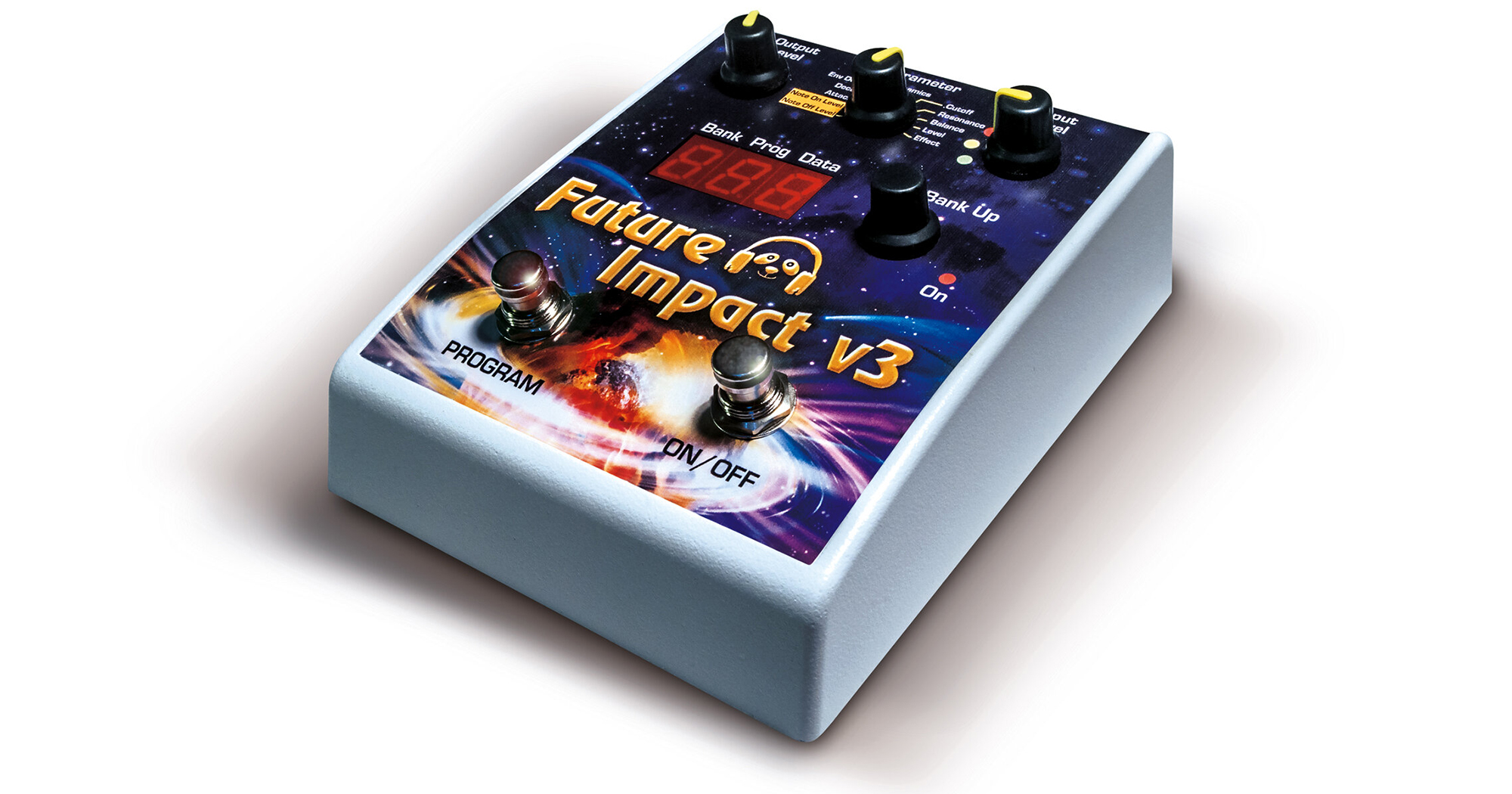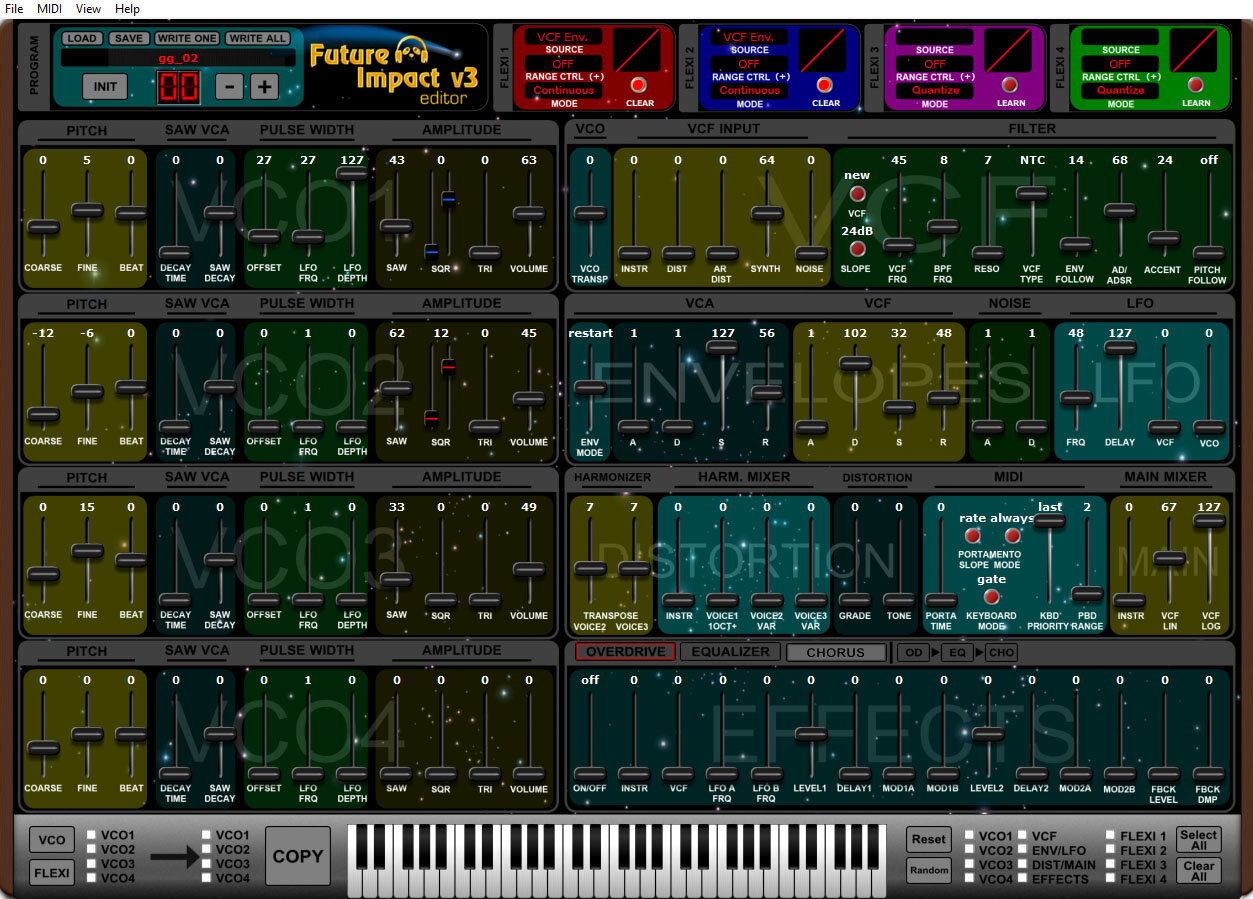Gear Review: Panda Audio Future Impact v3 Pedal

Is there anything more fun than a synth pedal? The ability to recreate vintage vibes and robot sounds is worth the price of admission, but the look on people’s faces when they realize it’s coming from the bass is priceless.
Seven years ago, synth wizard and pedal designer Andras Szalay revived the Deep Impact pedal he created for AKAI, which gained favor with players like Bootsy Collins, Muse’s Chris Wolstenholme, and Jamiroquai’s Paul Turner before it was discontinued in the early 2000s. The new pedal was dubbed the Panda Audio Future Impact. Now on its third iteration, the pedal has all the sounds of the Gen 1 with new features, including delay and tap tempo abilities, MIDI sync, sustain, and an improved management system in the editor suite.
We got our hands on one to get in on the fun.
The Panda Audio Future Impact v3 ships in a simple box with a two-page quick-start guide on its basic use. Don’t let that fool you because the FI’s full online manual is a 100-page in-depth dive into all this synth box has to offer.
The control layout works hard to get as much into the pedal’s footprint as possible. You have Input and Output level knobs as well as an on/off footswitch, all of which are straight-forward. The Program footswitch nudges up one program (preset), but pressing it twice will nudge it down one. If you’re in a hurry, you have to find the right rhythm to get to your setting; a steady click will go up, while a faster one will go down. You can leap through the programs faster by pressing on the Edit/Bank Up knob to cycle through the nine banks. Turning the same knob will adjust the data level settings for individual parameters.
Finally, the parameter knob lets you pick what parameters you’re adjusting: Attack, Decay, Envelope Depth, Dynamics, Cutoff, Resonance, Balance, Level, and Effect. It also has two global parameters – Note On Level and Note Off Level – that affect every one of the presets. Parameter data is displayed as the third digit on the display with a range of 1 through 9.
The 99 presets range from straight-ahead, classic synth sounds to some pretty off-the-wall effects. They’re arranged by instrument, with 67 marked for bass, 9 as effects, 9 for guitar, and 5 for EWI. All work for the bass, but the Future Impact v3 has different instrument modes – Bass, Split, Guitar, Synth, and EWI – that can be set on the pedal’s startup. I left it on Bass for my review, although the Split mode may be handy for anyone with a stereo rig. By splitting your signal before the pedal’s input, you can run your clean signal to one amp, then the FI mutes all direct signals, leaving only the synth signal as the output from the pedal.
Some sounds are iconic and inspiring, others are whimsical and puzzling – such as my personal favorite preset 53: “Bass Polka Madness.” Luckily, Panda Audio has a demo of each preset.
The Future Impact is monophonic, meaning it won’t respond to playing more than one note at a time. (Some of the effects can be set to produce four-note voicings, but that would only be for the effect output.) Its tracking, however, is very good and works the full scale of a 6-string bass with the low B tracking surprisingly well. You can dial it in further with the Note On and Note Off values, but some of the effects are designed to blossom and bloom, requiring focus on your technique to get the most out of it. The manual even states that “To a certain extent you must learn to play the pedal, much like you would need to learn to play any new instrument,” and I found this to be very true. The interaction between your input and each sound takes some thought, but it’s like a fun puzzle. Attention to clarity and attack is key to keeping the effects clean and not a warbly mess.
One of the most fun aspects is using pitch as your source for the effect split, where a lower register will be just your clean signal, but above that will be affected. This was especially cool with a looper to layer different textures and take leads over top. (See presets 41 and 42 in the video starting at 7:33.)
The parameter knob does not have any detentes. As you turn it, the third digit on the display, which is the parameter level, will blink off between parameters and come back on as you’re able to adjust the next. This was a little awkward at first but an easy hurdle.
In the same way that you must learn to play the pedal, you must also learn how the parameters affect each sound. Aside from the global Note on and Note Off values, each parameter affects the sound a bit differently. The pedal is pretty much a legitimate synthesizer, and understanding how each parameter works in conjunction with the filter stages is key to knowing what you’re doing. If you’re keen on tweaking or at least experimenting, this is no problem. The presets make for a wide array of plug-and-play effects, but dialing in your own sounds takes some time.

The Future Impact connects to your computer via MIDI to allow for using its editor. Again, the editor and sound manager are intricate tools to build your own tones or subtly tweak the existing ones. There’s also an online program database of user-created effects that you can load onto your FI. The amount of flexibility and control you have with this pedal makes it extremely powerful.
At $399, the Future Impact is an investment. Other synth pedals are on the market, but as the manual says, it pretty much is an instrument in and of itself. The set of possible sounds you can coax out, let alone the editing of the stock presets, is nearly endless. So get a hold of one if you’re into going deep on sound creation or if you just want to see the look on someone’s face as you unleash some Bass Polka Madness.
Panda Audio Future Impact v3 Features:
| 99 editable onboard sounds; many more available via the companion Editor Suite |
| Synth triggered either by an instrument’s audio signal or any MIDI-capable device |
| Super-fast and accurate pitch tracking over the full range of 6-string bass or guitar |
| Wide input and oscillator ranges - instruments of all pitches can be used |
| 4 VCOs each with saw, square (with variable pulse width) and triangle waveforms |
| Full ADSR envelopes, giving the ability of precise envelope shaping |
| Individual envelopes for the VCA, the VCF and the Noise source |
| 4 Flexi Controllers - a powerful real-time, user-controllable modulation matrix |
| 4 effects with configurable order - Chorus, Delay, EQ, and Overdrive |
| Resonant 12/24 dB/oct. filter with Lowpass, Highpass, Bandpass and Notch modes |
| 2nd, parallel Bandpass filter |
| Global LFO for VCOs and VCF |
| 10 additional LFOs - including saw, square, triangle and sample-and-hold types |
| Envelopes and LFOs freely assignable via Flexi Controllers |
| Expression control of most parameters via MIDI, including LFO, filter and volume |
| A 3-voice harmonizer with variable transposition on two of its voices |
| High-quality distortion for the harmonizer voices and dry input signal |
| Split Mode - only the synth signal is sent to the audio output so the input instrument |
| gnal can be split using a Y-cable or splitter box prior to the audio input socket |
| Synth and EWI Mode - audio input signal can be decoupled from the synth triggering |
| rcuit to allow independent triggering by MIDI whilst still playing your bass/guitar |
| Built-in tuner |
| Powered by a standard 9V, center-negative supply with current draw of only 100mA |
| Large 3-digit display - the current sound’s location number is visible at all times |
| An exciting factory default soundset created by experienced sound designers |
| All 99 sounds accessible directly from the pedal - no external equipment required |
| Ability to back up programs directly from the pedal to a computer |
| Rugged and road-worthy metal housing |
| Full-size MIDI IN and OUT ports |
| Relay-switched true bypass. |


At $199, it’s in my pedal board. But for $399 (at the posting of this article) I think the novelty might morph into buyer’s remorse. A well-built and thought out unit, though!